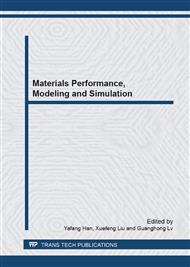[1]
L. Dong, G.X. Chen, M.H. Zhu, Z.R. Zhou, Wear mechanism of aluminum-stainless steel composite conductor rail sliding against collector shoe with electric current, Wear 263 (2007) 598–603.
DOI: 10.1016/j.wear.2007.01.130
Google Scholar
[2]
S.G. Jia, P. Liu, F.Z. Ren, B.H. Tian, M.S. Zheng, G.S. Zhou, Wear behaviour of Cu-Ag-Cr alloy wire under electrical sliding, Mater. Sci. Eng. A. 398 (2005) 166–262.
DOI: 10.1016/j.msea.2005.03.023
Google Scholar
[3]
D.F. Cannon, H. Pradier, Rail rolling contact fatigue research by the European rail research institute, Wear 191 (1996) 1–13.
DOI: 10.1016/0043-1648(95)06650-0
Google Scholar
[4]
T. Ding, G.X. Chen, M.H. Zhu, W.H. Zhang, Z.R. Zhou, Influence of the spring stiffness on friction and wear behaviours of stainless steel/copper-impregnated metallized carbon couple with electrical current, Wear 267 (2009) 1080-1086.
DOI: 10.1016/j.wear.2008.12.098
Google Scholar
[5]
G.X. Chen, F.X. Li, L. Dong, M.H. Zhu, Z.R. Zhou, Friction and wear behaviour of stainless steel rubbing against copper-impregnated metalized carbon, Tribol. Int. 42 (2009) 934-939.
DOI: 10.1016/j.triboint.2008.12.011
Google Scholar
[6]
S. Kubo, K. Kato, Effect of arc discharge on wear rate of Cu-impregnated carbon strip in unlubricated sliding against Cu trolley under electric current, Wear 216 (1998) 172-178.
DOI: 10.1016/s0043-1648(97)00184-1
Google Scholar
[7]
D. Klapas, F.A. Benson, R. Hackam, P.R. Evison, Wear in simulated railway iding wear behavior of rate of overhead current collection systems, Wear 126 (1988) 167-190.
DOI: 10.1016/0043-1648(88)90136-6
Google Scholar
[8]
H. Nagasawa, K. Kato, Wear mechanism of copper alloy wire sliding against iron-base strip under electric current, Wear 216 (1998) 179-183.
DOI: 10.1016/s0043-1648(97)00162-2
Google Scholar
[9]
F. Akhlaghi, A. Zare-Bidaki, Influence of graphite content on the dry sliding and oil impregnated sliding wear behavior of Al 2024-graphite composites produced by in situ powder metallurgy method, Wear 266 (2009) 37-45.
DOI: 10.1016/j.wear.2008.05.013
Google Scholar
[10]
A.R. Riahi, A.T. Alpas, The role of tribo-layers on the sliding wear behavior of graphite aluminum matrix composites, Wear 251 (2001) 1396-1407.
DOI: 10.1016/s0043-1648(01)00796-7
Google Scholar
[11]
M.L.T. Guo, C.Y.A. Tsao, Tribological behavior of aluminum/SiC/nickel-coated graphite hybrid composites, Mater. Sci. Eng. A. 333 (2002) 134-145.
DOI: 10.1016/s0921-5093(01)01817-2
Google Scholar
[12]
M. Kestursatya, J.K. Kim, P.K. Rohatgi, Wear performance of copper–graphite composite and leaded copper alloy, Mater. Sci. Eng. A. 339 (2003) 150-158.
DOI: 10.1016/s0921-5093(02)00114-4
Google Scholar
[13]
A.K. Jaha, S.V. Prasad, G.S. Upadhyaya, Dry sliding wear of sintered 6061 aluminum alloy graphite particle composites, Tribol. Int. 22 (1989) 321-327.
DOI: 10.1016/0301-679x(89)90147-3
Google Scholar
[14]
B.K. Yen, T. Ishihara, Effect of humidity on friction and wear of Al–Si eutectic alloy and A1–Si alloy–graphite composites, Wear 198 (1996) 169-175.
DOI: 10.1016/0043-1648(96)06955-4
Google Scholar
[15]
S. Basavarajappa, G. Chandramohan, A. Mahadevan, M. Thangavelu, R. Subramanian, P. Gopalakrishnan, Influence of sliding speed on the dry sliding wear behaviour and the subsurface deformation on hybrid metal matrix composite, Wear 262 (2007).
DOI: 10.1016/j.wear.2006.10.016
Google Scholar
[16]
J.B. Yang, C.B. Lin, T.C. Wang, H.Y. Chu, The tribological characteristics of A356. 2Al alloy/Graphite (p) composites, Wear 257 (2004) 941-952.
DOI: 10.1016/j.wear.2004.05.015
Google Scholar
[17]
N. Martin, G.N. Ogden, J.W. Patrick, A. Walker, Binder/filler interfaces in anode carbon: Their classification, development, and effects, Carbon 30 (1992) 487-494.
DOI: 10.1016/0008-6223(92)90048-2
Google Scholar
[18]
M. Hashiba, Y. Hirohata, T. Hino, H. Shinbori, S. Deyama, H. Chiyoda, Gas desorption and adsorption properties of graphite and water glass mixtures used as inner coatings of a cathode ray tube, Carbon 36 (1998) 1133-1138.
DOI: 10.1016/s0008-6223(98)00088-8
Google Scholar
[19]
H.J. Yang, R.Y. Luo, S.Y. Han, M.D. Li, Effect of the ratio of graphite/pitch coke on the mechanical and tribological properties of copper-carbon composites, Wear 268 (2010) 1337-1341.
DOI: 10.1016/j.wear.2010.02.007
Google Scholar


